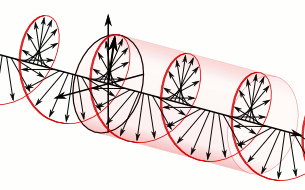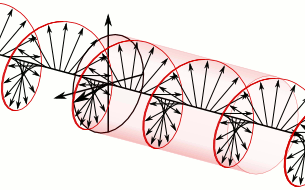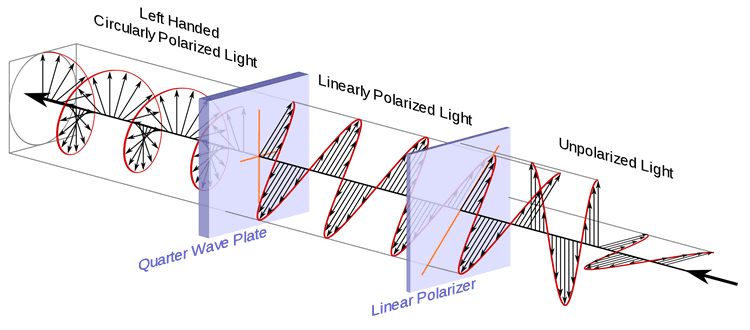Polarization for 3D
You don't need to understand polarization to be able to enjoy a movie from a polarizing 3D projector, but here's a basic explanation for if you're curious...
The first thing you need to know is that light travels in the form of light waves. And usually these waves are oscillating in all sorts of directions. They're moving forward overall (away from the light source that they came from), but the waves are oscillating in lots of directions perpendicular to their forward motion.
Polarization cuts out the oscillation of the light waves in some directions, leaving light waves that are oscillating more uniformly.
There are two types of polarization that are relevant to 3D TV: linear polarization and circular polarization. Circular polarization builds on linear polarization.
Linear polarization
Linear polarization is the simple one...
As mentioned above, usually light waves are oscillating in all sorts of directions. But a linearly polarized light filter makes it so the light that passes through is oscillating in one direction only. This reduces the intensity of the light, but it doesn't limit the colours that can pass through, which is good for 3D TV.
If the linearly polarized light reaches another linearly polarized filter (like that on your polarized glasses), the amount of light that gets through depends on the angles of polarization. If the polarized filter is polarized in the same direction as the light, the light gets through. If the filter is polarized in a perpendicular direction to the light, the light doesn't get through. If it's some way between, some of the light gets through.
The polarizations of the two images from the 3D projector are matched with the polarizations of the two lenses on the glasses, such that each eye can only see the image that is intended for it.
Circular polarization
Circular polarization is more complicated. Circularly polarized light can either be polarized clockwise or anti-clockwise. The images below highlight the two:


NB Physicists label the direction that the wave is circularly polarized by considering the way it rotates as seen in the direction it's coming from (versus the direction it's going). Hence the clockwise/anti-clockwise definitions above.
How can a polarizing filter make a circularly polarized wave?
This is the tricky question... It seems there are a number of ways to do it. But the diagram below shows a method that uses a two-step approach:

NB1 The light going into the filter above is labelled as "unpolarized". But the diagram makes it look as though it's oscillating in two directions only. In reality it would be all over the shop, but all over the shop is hard to depict in a diagram.
NB2 The polarized light coming out of the filter is labelled as "left handed". This basically just means anti-clockwise. The left-handed/right-handed terminology is something that physicists use. For a left-handed wave (or electric field), if you point your left thumb against the direction of travel (i.e. towards the source), your fingers curl in the direction that the wave rotates. And for a right-handed wave (or electric field), if you point your right thumb against the direction of travel, your fingers curl in the direction that the waves rotate.
Here's roughly how the circularly polarizing filter above works:
- A linear polarizer polarizes the light waves such that they are oscillating in one direction only.
- A quarter wave plate polarizes the light in two directions. It's a little complicated to visualize, but, when any one polarized light wave passes through the quarter wave plate, the combination of the natural wave-like variation of its amplitude and the quarter wave plate causes it to come out circularly polarized. And the same happens to all the linearly-polarized waves that pass through the quarter wave plate.
Which sort of polarization is better for 3D?
Linear polarization doesn't work so well if you tilt your head. Tilting your head changes the angle of the polarizing filters in each eye, and each filter will start to block more of the light that it should be letting in (the light from its eye's image), and let in more of the light that it shouldn't (the light from the other eye's image).
Circular polarization doesn't have this issue because it filters the same whatever angle it's titled at. So you can tilt your head and your eyes will still be seeing their respective images only.
However, even with circular polarization, the 3D experience always suffers if you tilt your head a lot, as the images for the left and right eye are recorded and displayed for left and right eyes that are horizontally aligned. So really you need to keep your head fairly upright to see the 3D image properly anyway. But circular polarization is less sensitive to the tilt of your head, so it does have an advantage.